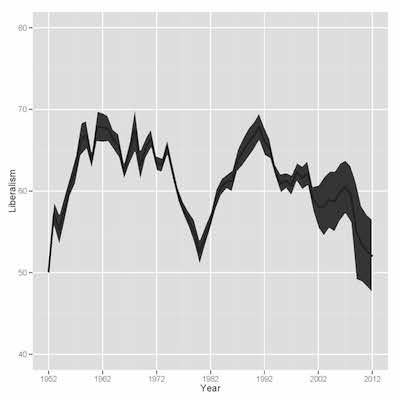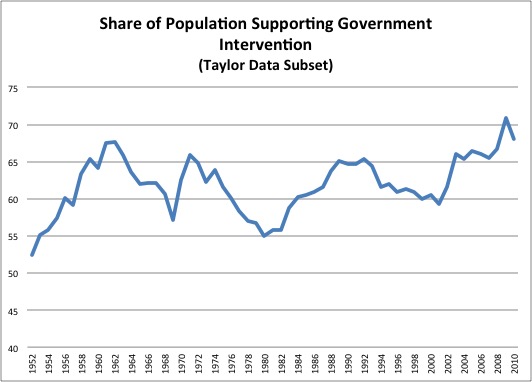The policy mood dataset created by Prof. James Stimson is a sobering reality check for libertarians. When Americans are asked specifically about whether they support more or less government in various policy arenas – even when price tags are mentioned – they tend to opt for more government. As George Will has long argued, the public is attitudinally conservative and operationally liberal.
Of particular interest are changes in the degree of public support for government over time. Whether we look at the total policy mood database (which records survey responses on a liberal/conservative continuum, not all of which line up well with “more or less government” as libertarians would define that concept) or my “Taylor” data subset (which considers only economic interventions that are clearly about more or less government), we find a pattern. The public appetite for government moves in opposition to the presidential appetite for government.
Above we see the policy mood data – with error bars – as updated by political scientist K. Elizabeth Coggins.
Above we see the policy mood data pertaining specifically to economic issues where public sentiment for (and against) government can be found cleanly. I produced that figure by using the policy mood custom series application and incorporating survey questions pertaining to macroeconomics, comprehensive health care reform, labor, employment, social welfare, housing, community development, banking, finance, and domestic commerce.
Prof. Stimson concludes that the public is quite clearly center-left. Republican presidents typically give them less government than they want, so public support for government intervention goes up under Republican administrations. Democratic presidents typically give them more government than they want, so public support for government intervention goes down under Democratic Administrations.
Doubt that? How else might we explain why the two “great communicators” of post-war American politics – Ronald Reagan and Bill Clinton – were unable to move the public in their direction? In fact, they moved the public in the direction of their opponents.
Prof. Stimson’s theory would seem to contradict John Zaller’s theory of public opinion, a theory which reigns as orthodoxy in the political science community. Prof. Zaller argues that elite opinion dictates public opinion. Prof. Stimson argues that presidential administrations dictate public opinion.
Those two arguments, however, can be reconciled. If opinion elites are, on balance, moderately center-left, then their reaction to the president – complaining about too much government when Democrats are in control of the White House and too little government when Republicans are in control of the White House – would dictate the attitudes of the general public. Moreover, if the public is center-left pace cues from elites, their thermostatic response to questions about whether they support more or less government will naturally be informed by their sense about whether they are satisfied with the amount of government they believe they are getting at present.
If Prof. Stimson is correct – and I think he is – it means:
- Those engaged in the “war of ideas” have failed to move public opinion away from the present center-left consensus;
- The public’s increasing opposition to government will likely reverse when a Republican takes office; and
- Libertarians will get more political traction by emphasizing policy ideas that fall within that center-left consensus than by offering ideas that don’t.
It gives me no great joy to tell this story. But comfortable fantasies about the political terrain do us no good.

